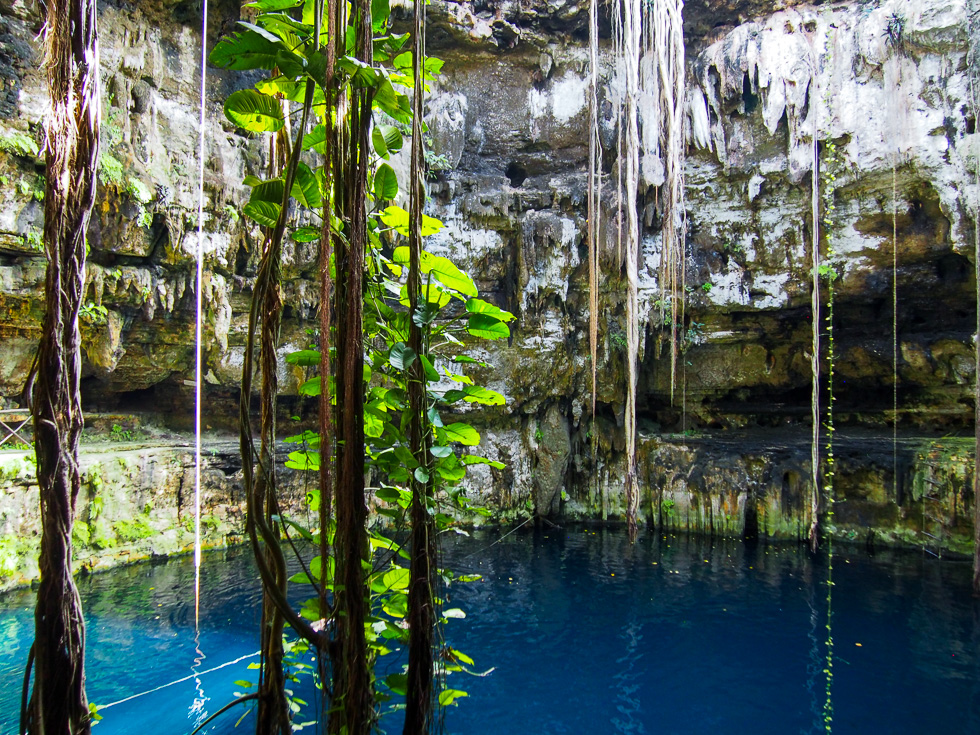
In order to preserve pristine natural areas, such as Cenote San Lorenzo Oxman outside of Valladolid, Mexico, we must all do our part to reduce our waste while traveling
While traveling, certain sites are par for the course: beautiful landmarks, amazing natural wonders, and stunning landscapes. And trash, lots of trash. Have you ever found yourself wandering a picturesque beach, only to see plastic littering the shoreline? How about a foreign city, with garbage tossed on the ground everywhere, from famous cultural sites to residential neighborhoods? Globally, we’re in a trash epidemic: it’s everywhere and we generate so much of it, which is incredibly taxing on the environment and the earth’s natural systems, such as our forests, rivers, and oceans. But there is a solution (many solutions, in fact) to our global waste problem. What we’ll discuss today is one way to combat waste and plastic pollution, through zero waste travel.
Zero waste has become a pretty hot buzzword recently, but what exactly does it mean? Basically, zero waste is a concept that encourages the creation of as little waste as possible. In practice, the zero waste movement utilizes individual choice and purchasing power as part of a larger movement to live more sustainably and intentionally than we are culturally taught.
I believe that zero waste is valuable as a concept because it challenges the status quo. We live in a world that encourages us to buy so much, use things until they break or we get tired of them, and then throw them away. Zero waste challenges this throwaway culture, especially with respect to single use plastics, which are hard to recycle and tend to just end up in our oceans. It teaches us to think intentionally about the things that we need or don’t need, and consider the environmental impacts of our choices. As travelers, I believe that it’s especially important to uphold certain zero waste values – namely challenging our use of disposables and single use plastics – because when traveling we have the luxury of using local resources, generating waste… and then leaving. I’m a strong proponent of trying to leave no trace while traveling, and I believe that attempting to be zero waste while traveling is one way to actualize that.
So to assist any and all travelers who are looking to reduce waste and decrease their environmental footprint while traveling, here is my eco-friendly packing list for more sustainable travel!
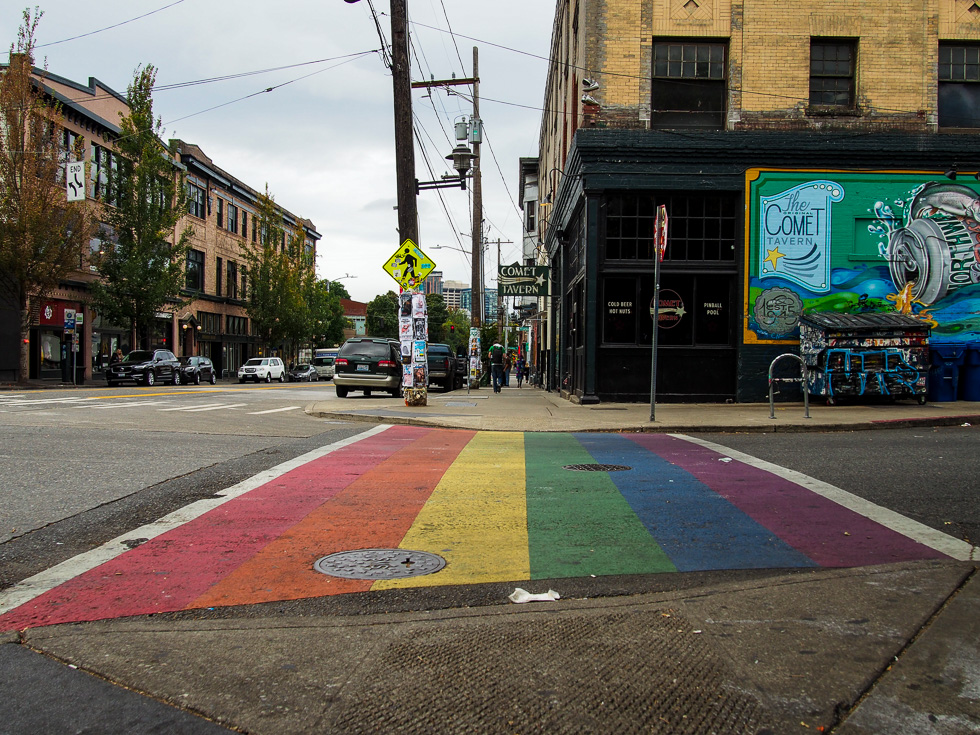
I love these pro-LGBTQ, rainbow sidewalks in the Capitol Hill neighborhood of Seattle. What I don’t love is the litter throughout the street. Let’s do our part to leave no trace, especially while traveling.
Note: this post may contain affiliate links. If you make a purchase through one of these links, I will earn a commission at no extra cost to you. Also, if you do make a purchase through one of these links, be sure to check out this great article on how to get (near) zero waste orders from Amazon!
Reusable water bottle/coffee cup
Let’s start with the most obvious: water bottles. Disposable water bottles are terrible for the environment. They take anywhere from 450 to 1,000 years to biodegrade, and between the water and crude oil needed to create plastic bottles, they are approximately 2,000 times more energy intensive than tap water. Around 90% of plastic water bottle brands have been shown to be contaminated with microplastics. And to top it all off, water companies are known for their human rights violations, when the privatization of water puts profit over human well-being and access to clean water. All in all, disposable water bottles suck.
So don’t forget your reusable water bottle on your next trip. Not only will it cut costs (purchasing water every day adds up!) but it’s also a simple and effective way to promote environmental health and human rights. I use a reusable BPA-free plastic bottle, but there are also great glass and stainless steel options available for folks trying to avoid all plastic. Also, if you’re going to be traveling to a place where you can’t drink the tap water, keep reading! Below I list some zero waste water options for travel in water unsafe regions too.
Click here to purchase a glass water bottle, and click here to purchase a stainless steel water bottle.
Also, I am a daily tea drinker, so my reusable hot beverage cup is a must for traveling. Now when I travel I not only bring my reusable water bottle, but a reusable travel mug as well. Click here to purchase a stainless steel travel mug for on the go coffee and tea sipping!
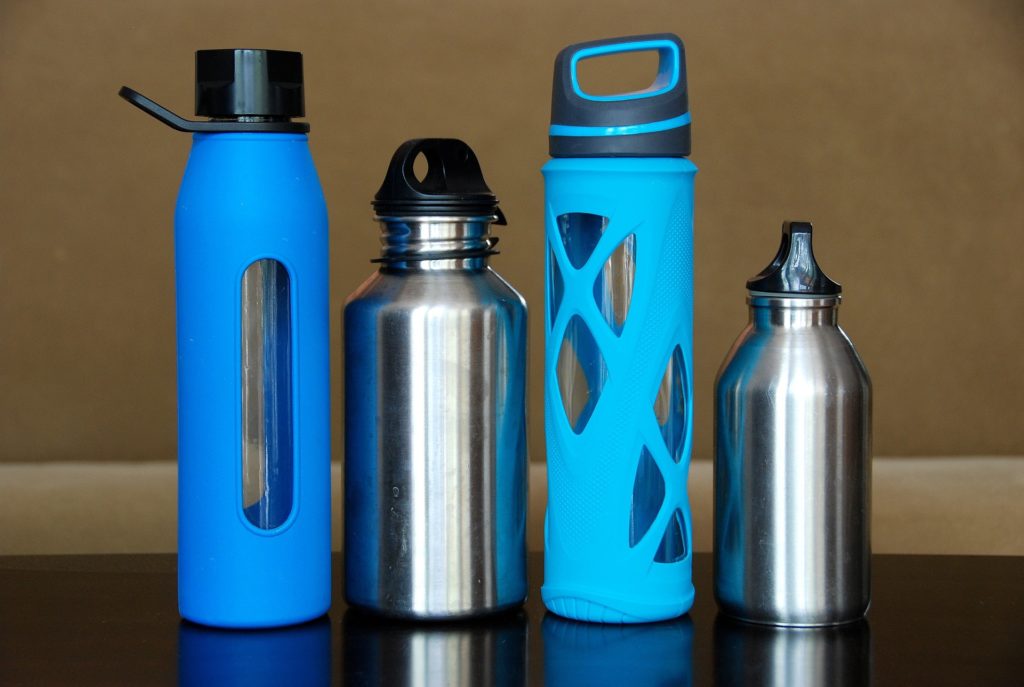
Reusable water bottles are a must-have for travelers!
Tote bag
Tote bags are super versatile and perfect for travelers. Any reusable bag works, and they are light and easy to toss into your suitcase for zero waste travel. Every time you opt for a reusable bag over a plastic bag, that’s one less plastic bag that ends up in the ocean.
I have a ChicoBag brand tote that I take with me on every trip, and I love it for so many reasons. 1) It’s large – large enough for a big grocery haul or trip to the local market, and also large enough to store my excess things that don’t fit into my suitcase or backpack. 2) It can handle a lot of weight. I double this bag as a carry-on when flying, and I usually put my computer and my purse inside. Not only is there room to spare, but I’ve done this on many trips and my ChicoBag doesn’t show any signs of wear and tear. And 3) It’s compact. When I’m not using it, it folds up to be about the size of a fist, and you can clip it onto your bag and take it with you in case any spontaneous shopping happens during a day of tourism.
Click here to purchase the ChicoBag tote.
Cloth napkins/handkerchiefs
Cloth napkins and handkerchiefs are a great way to reduce your paper waste while traveling, especially because travelers tend to eat many meals in restaurants (and thus end up going through a lot of disposable napkins). I tend to travel with two cloth napkins and one or two handkerchiefs per week of travel, depending on the climate of the travel destination (colder climate = more nose blowing and thus more handkerchiefs!). Cloth napkins and handkerchiefs are so easy to travel with – they’re small and lightweight, and they can be tossed in with your laundry on laundry days.
If you don’t have a set of cloth napkins or handkerchiefs, you can upcycle an old T-shirt, sheet, or towel into napkins and handkerchiefs. Otherwise, click here to purchase a set of cloth napkins made from sustainable fabric, and click here to purchase a set of organic cotten handkerchiefs.
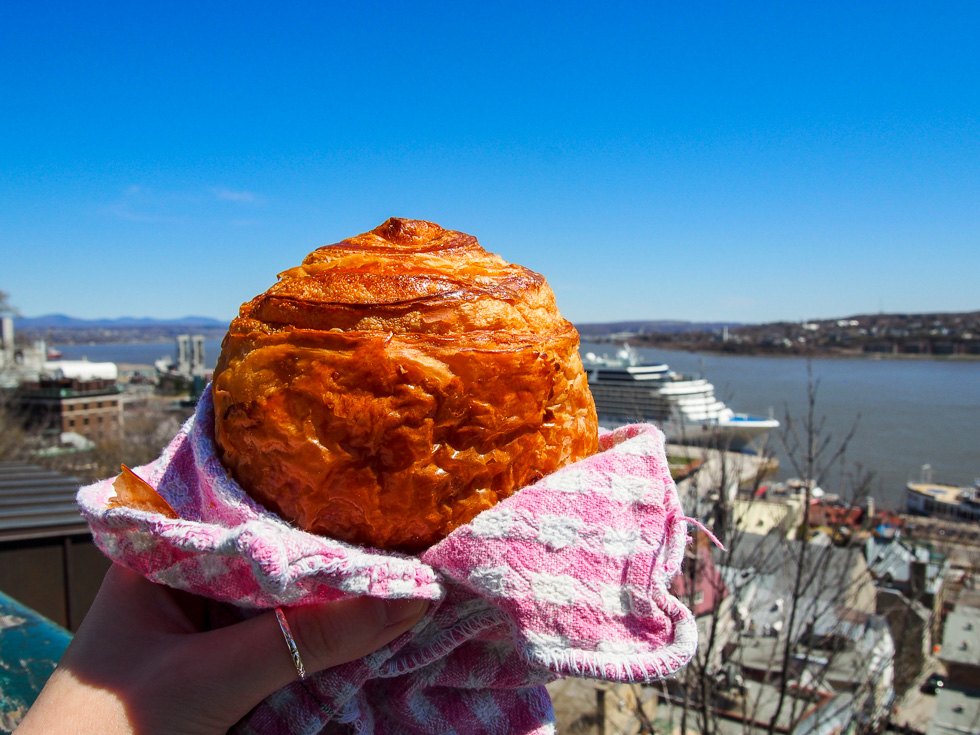
Zero waste breakfast in Quebec City, Canada: a chocolate croissant taken to go in my cloth napkin. Yum!
Food storage containers
Food storage containers, such as Tupperware and the like, are easy to throw into your suitcase and serve a variety of uses. They can be used to store leftovers from restaurants and hostel dinners, and they are also a great way to organize small items in your suitcase when they don’t contain food.
Plastic or stainless steel food storage containers too bulky for your suitcase? I found the perfect fix. I recently invested in some collapsible silicone food storage containers and I love them. The containers barely take up any room in my suitcase, and they are lightweight and easy to throw into a daypack for some “just in case” leftovers storage. I bought a pack of four and usually travel with two sizes, typically a small and a large. I also invested in reusable zipper bags (similar to Ziplock bags, but made from silicone), which are also great for traveling and are an even more compact option for food storage when traveling.
Click here to purchase a set of collapsible silicone food storage containers, and click here for a set of reusable zipper food storage bags.
Sustainable menstrual products
I’ve talked up sustainable menstrual products throughout this blog, because they’re a godsend for the traveling menstruator. Seriously. There are so many options for eco-friendly, body-friendly menstrual products, including menstrual cups, reusable pads, organic pads and tampons, period underwear, and more. I wrote a whole guide on the pros and cons of each different sustainable menstrual product for travel, which you should totally check out. Also, don’t miss my interview with traveler and menstrual activist Emilie Pichot, where we discuss sustainable menstrual products and menstruation politics around the globe.
While there are so many great sustainable menstrual products to chose from, what works best for me is the Diva Cup, which is a type of menstrual cup. I’ve found it easy to use and great for travel. I can’t recommend it enough. Click here to purchase a Diva Cup.
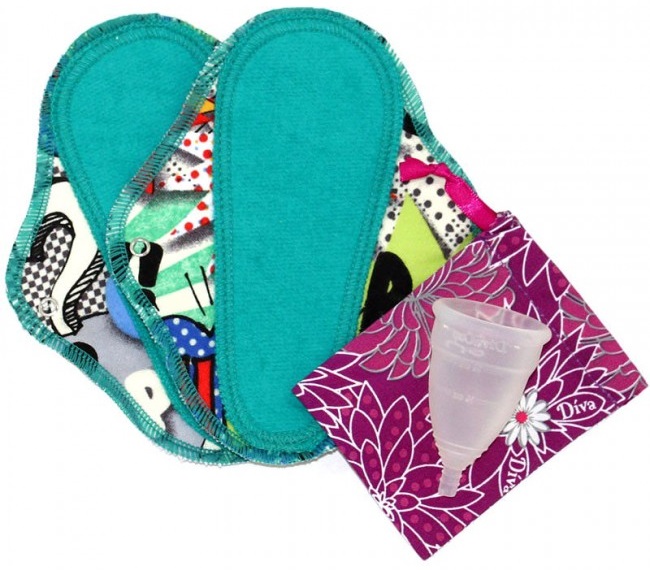
Reusable pads and a menstrual cup! (Photo by Lunapads)
Bulk bath products
Staying in a fancy hotel? Great! But you can enjoy the perks of the hotel while saying no to all of those little soap and shampoo bottles that are left in your hotel bathroom. I know, I know – they’re so cute! But small, single use items like this are wasteful, especially when it’s so easy to bring your own toiletries. Get yourself a kit with some empty, TSA-approved bottles that you can fill up with your shampoo, conditioner, face wash, etc. before leaving for your trip. And better yet, try solid options when possible, such as solid bar soap and shampoo (which are easy to find without packaging). I recommend solid shampoo from Lush, and Sappo Hill soap, both of which come package free!
Click here to purchase a TSA-approved kit for transporting liquids while traveling.
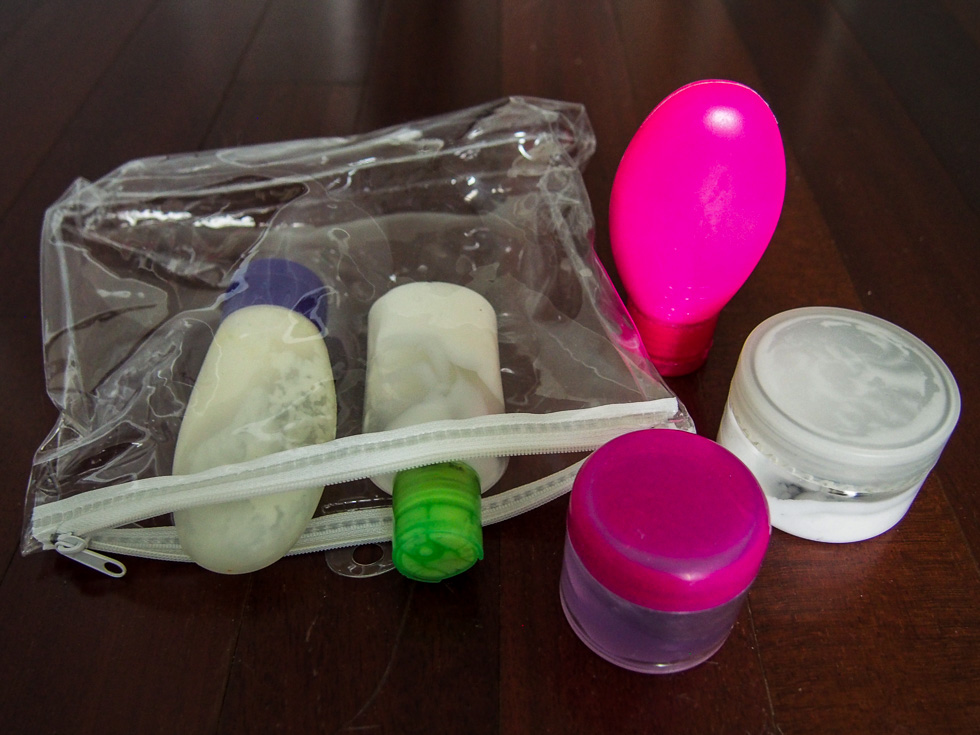
This is the bag that I use on all of my trips. It fits multiple 3-oz. containers, so I rarely have to buy toiletries while traveling.
Filtered water bottle/water purifyer
Traveling to a country or region where the water is not safe to drink? There are a number of options available for travelers looking to avoid disposable water bottles. One option is a water bottle with a built in filter. Lifestraw is a popular brand that makes water bottles with filters for travel and camping. Another option is to purify water via a portable UV light, such as a Steripen. Although the upfront cost of a filtered water bottle or a Steripen is high, the money that you can save by not purchasing bottled water (especially during long-term travel) will allow it to pay for itself. Plus, think of all of those plastic water bottles you’ll save!
Click here to buy a Lifestraw water bottle with a filter, and click here to purchase a Steripen water purifyer.
Biodegradable sunscreen
Here’s a little known fact: sunscreen has been linked to the degradation of coral reefs, due to the chemical oxybenzone that is used in most commercial sunscreens. Many ecologically sensitive sites around the world, such as the cenotes in the Yucatan in Mexico, advise travelers to use a biodegradable and/or reef-safe sunscreen when swimming at or near these sites. There are many options for eco-friendly sunscreen. Look for sunscreens that are mineral-based, made from titanium oxide or zinc oxide.
Raw Elements is a natural, biodegradable sunscreen brand that is zinc-based, provides UVA and UVB protection, and is reef safe. Click here to purchase Raw Elements biodegradable sunscreen.
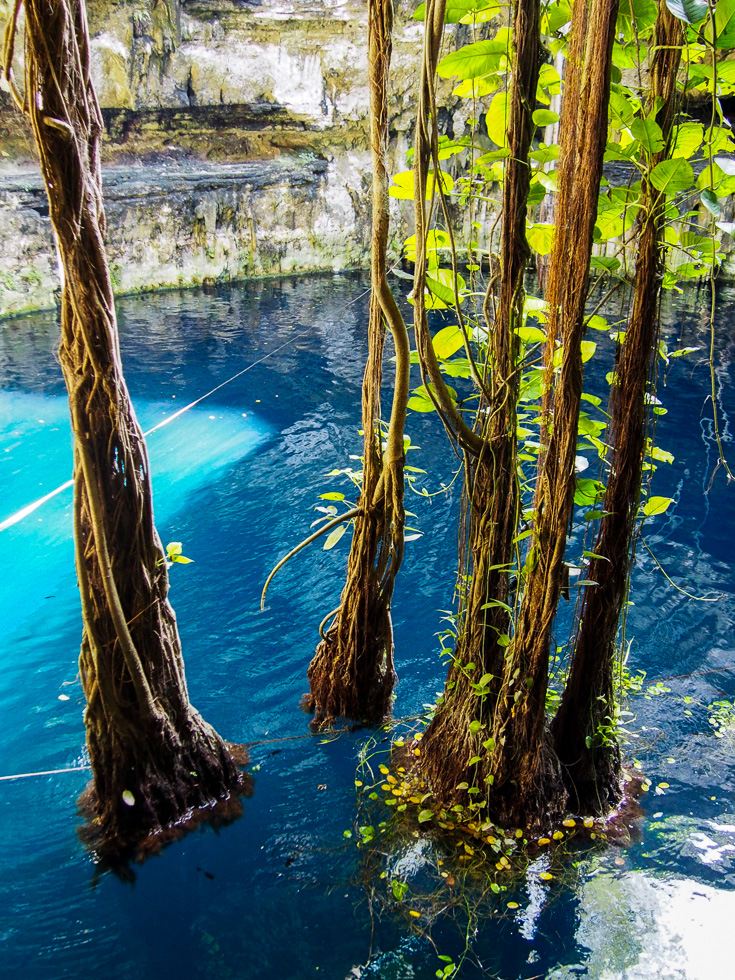
When you look closely, you can see small fish swimming near the base of these vines in Cenote San Lorenzo Oxman. Swimming is allowed in this cenote, but it is important to use biodegradable sunscreen that is safe for cenotes, to protect these fragile ecosystems.
Solar-powered charger
For folks who like gadgets, why not consider a solar powered battery charger for your next trip? It saves the hassle of having to locate a plug converter for the wall every time you want to charge your phone while abroad. Plus, it’s perfect for adventure travelers and hikers who spend a lot of time in the sun. You can get a lightweight, portable solar charger which charges directly to a plugged in device, or spluge a little more for a battery pack which allows you to save some of the stored power to charge later.
Click here to purchase a solar charger.

Okay, perhaps you don’t need quite this much power… but a small, portable charger will do the trick!
Compost container
Finally, why not compost while on the road? Okay, for travelers who are hopping from city to city on public transit, this one might be tricky, but for roadtrippers it’s a no-brainer! Why not throw a spare food storage container or other sealable container into your car and collect your compostable waste there? Many cities have community composting locations where you can drop off your compost. Compost diverts so much waste from landfills, and is a great example of a circular system (basically, a system that allows for the infinite recycling of materials).
I brought a compost container with me on a 10-day-long roadtrip and I’m glad I did! Any container works, but there are also plenty of nifty odor-free containers that you can check out. Click here to purchase an odor-blocking compost bin.
In conclusion…
With just a few small changes, we can drastically reduce our waste while traveling. I believe in the power of small changes, especially when they are conversation starters and we work collectively to educate folks on the importance of decreasing our environmental footprint. I also believe that individual changes should only be one piece of the environmentalism puzzle. Go ahead and try for zero waste travel at an individual level on your next trip (and beyond zero waste travel, don’t miss some of my general eco-friendly travel tips). And when you get back, continue to put that green energy to work by advocating for systemic change that benefits the environment and all the people who inhabit it.
Get involved in your community garden (or start one, if your community doesn’t have one!). Advocate within your community for more sustainable practices, such as recycling, composting programs, farmers markets, and more. Support and elect officials into government that are actively working on environmental issues. Donate to organizations that are working on the local, regional, or even international level to fight climate change and protect the environment. Yes, I believe in individual impact, and especially the ripple effect of individual impact. But while I love zero waste travel, we shouldn’t stop there. There are so many ways to get involved to advocate for a cleaner planet, beyond an individual level.
There you have it. I wish you the best of luck in your zero waste travels and environmental activism, for a more sustainable present and future!
Do you try to travel zero waste? What are your tips to reduce waste while traveling? Any recommendations for zero waste travel gear? How do you take action for the environment, while traveling or not traveling? Let me know in the comments below!
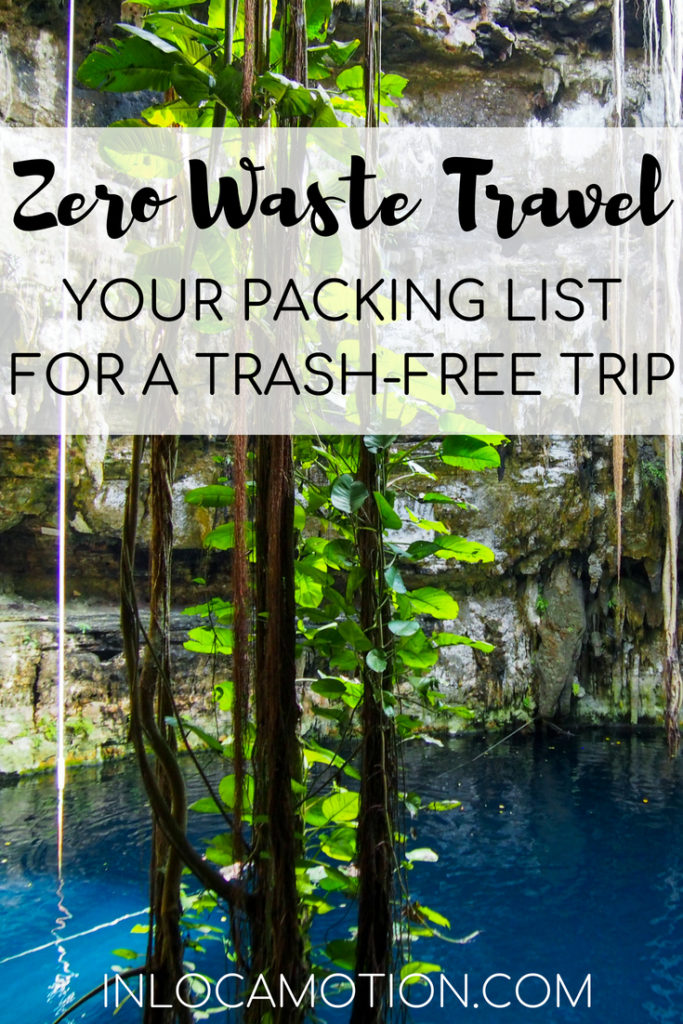









12 comments
I love this post and I love that you don’t treat the term zero waste in a buzzword sort of way. P.S. I need to get a solar powered charger!
Aw, thank you so much! Enjoy the charger!!
These are great tips. I love my Lifestraw filter bottle. Not only does it save so many plastic bottles, it also only costs about 4 cents per liter of water – way cheaper than buying so many bottles. In Cuba, the bottled water was so expensive, the amount I saved on that 2-week trip exceeded the cost of the bottle.
Thanks, Lisa! Good to know that you’ve had a good experience with LifeStraw – I’m debating whether I should go with that or a Steripen for my next trip… Thanks for reading and commenting 🙂
Great suggestions! I hadn’t thought about a cloth napkin or compost container. I’m in Berkeley, California, and the city requires residents to separate out recycling, compost, and trash. Having the compost option makes me think a lot more on what I can do with food scraps when I’m not at home. I’m glad you mentioned this idea so I can try it out the next time I’m traveling!
Thanks for sharing your thoughts, Brooke! Yeah, I really appreciated being able to roadtrip with a little compost container, because tossing food scraps is just suuuuch a bummer. It would be tough in other forms of travel, I think, but made perfect sense during that trip. It’s great that composting is required in Berkeley! Anyway, thanks for reading and commenting 🙂
Love this! Thanks for the great ideas!
I’m so glad you like the post! Thanks for reading and commenting, Jessica 🙂
Cheers for this! A lot of travelers leave tons of trash when they travel and that’s why a lot of tourists destinations are polluted. Here in the Philippines, we h ad to close our most famous beach, Boracay, because of the pollution caused by local and foreign tourists. I hope more people read this!
Thank you for your support. It’s terrible what happened in Boracay – tourists definitely need to learn how to pick up after themselves and take care of the local environment!
I absolutely love these tips. I never thought about solar-powered gadgets before but you’re totally right! That’s such a great idea. Also – we just started composting so I’m super into the idea of composting on longer stays. Thanks for these great tips!
Thanks, Rebecca! I’m a huge fan of composting too – it’s such an easy way to divert sooo much waste from the landfill. Thanks for reading and commenting 🙂